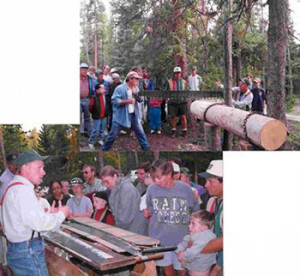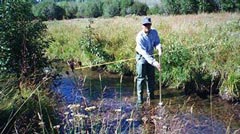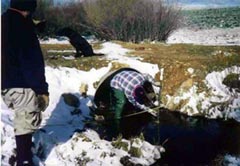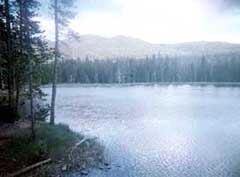Colorado State Forest – Integrated Management
Under agreements with the Colorado State Land Board, multiple agencies including the Colorado State Forest Service, Colorado Parks & Wildlife and Jackson County; concessionaires and private individuals cooperatively manage the Colorado State Forest (CSF).

The Colorado State Forest Service (CSFS) is responsible for forest management while Colorado Parks & Wildlife is responsible for recreation management. Management activities on the CSF are guided by plans approved by the State Land Board. An integrated planning process, designed to incorporate all resource planning into one document, was completed in May 2001.
Forest Management
The Colorado State Forest Service mission on the Colorado State Forest includes demonstrating sound forest management practices; researching and innovating forest practices to improve forest health; and providing the state trusts with direct financial and educational benefits. The goal of the forest management program specifically is to maintain a healthy forest capable of sustaining a flow of values and products in perpetuity.
We define a healthy forest as one where insects and disease levels are not excessive and diverse, vigorous wildlife populations are supported. A sound forest also should produce a variety of high-quality wood products, clean water and recreation opportunities.
The CSFS practices an adaptive management strategy on this forest. The Oregon Department of Forestry defines adaptive management as “the process of monitoring and analyzing management actions to understand their effects, and then adjust plans accordingly. It acknowledges that we do not fully understand ecosystem processes, especially across landscapes, through time, and in response to natural or human-induced changes. This is accomplished through research and monitoring.”

This simply means that we are constantly gathering data on resources within the Colorado State Forest and adjusting our management accordingly. Forest management activities, particularly timber harvesting, are carefully planned and coordinated with the other management agencies. Various species are managed in different ways to emulate natural processes which help to ensure effective product utilization and a healthy forest condition in perpetuity. Analysis and extensive environmental monitoring programs are integral components of forest management on the CSF.
Education
The primary beneficiaries of state trust lands in Colorado are the public schools of Colorado.
Although those benefits traditionally have been measured in terms of dollars, the Colorado State Board of Land Commissioners recognize the important role that some state lands can play in providing outdoor education opportunities.
The CSF is actively used today for ongoing research projects and educational programs by both the local North Park School District and by state universities and colleges in Colorado.
The CSFS and Colorado Parks & Wildlife participate in interpretive and educational programming.
Wildlife Monitoring

Ongoing monitoring projects have been designed to provide indicators of relative health for the major habitat aggregates within the CSF.
Monitoring is done on northern goshawks, boreal owls, macroinvertebrates and migratory land birds.
The four species or species groups monitored are indicators for forest habitat in general, and for subalpine forest, aquatic and riparian habitats.
These monitoring projects have been underway since 1995 and were developed in partnership with the Colorado Parks & Wildlife.
Monitoring has since been directly supported by CSFS and the State Land Board, and is actively used to adjust management techniques to meet resource needs.
Water Quality Monitoring
 Water quality monitoring on the forest began in 1995 through the cooperative efforts of the State Land Board, the Owl Mountain Partnership and the CSFS.
Water quality monitoring on the forest began in 1995 through the cooperative efforts of the State Land Board, the Owl Mountain Partnership and the CSFS.
A grant was received from the Environmental Protection Agency’s 319 non-point source water quality program. The program makes federal funds available to assist states in developing and implementing programs for controlling non-point sources of pollution.
The objectives of the water quality monitoring project are to:
- Identify stream or river segments within the boundaries of the CSF that may have high sediment loads;
- Collect information that would help judge the effectiveness of Best Management Practices (BMPs) following their implementation; and
- Establish baseline data on current water quality conditions.
 Currently, 11 water quality monitoring sites are located at various points along the watersheds of the Canadian and Michigan rivers, the two major drainages on the site. Cooperation of the private landowner adjacent to the CSF has been critical to the success of this monitoring program, as four of the sampling sites are on private land outside property boundaries.
Currently, 11 water quality monitoring sites are located at various points along the watersheds of the Canadian and Michigan rivers, the two major drainages on the site. Cooperation of the private landowner adjacent to the CSF has been critical to the success of this monitoring program, as four of the sampling sites are on private land outside property boundaries.
Monitoring on the sites is done in the spring and again in the fall. The results are positive and show good to excellent water quality across the range of monitoring sites.
Grazing
Livestock grazing is a traditional activity on the CSF and surrounding private and public lands. Ranching is an important part of North Park’s economy and way of life. The benefits we all enjoy from ranching go beyond the meat we buy at the supermarket. Ranching in North Park has maintained open space and habitat for wildlife that everyone appreciates.
 There are eight active grazing allotments on the CSF today. A grazing management plan for the forest and surrounding public and private lands was completed in the spring of 2000. The plan represented a cooperative effort between local, state and federal agencies and the Silver Spur Ranches.
There are eight active grazing allotments on the CSF today. A grazing management plan for the forest and surrounding public and private lands was completed in the spring of 2000. The plan represented a cooperative effort between local, state and federal agencies and the Silver Spur Ranches.
Livestock grazing occurs on the property from about the beginning of July to the end of September. Cowboys move the cattle through the pastures on the forest to manage the overall range condition and to prevent them from congregating in riparian areas. Properly managed grazing can be an effective means of reducing fuels and stimulating range production.
Recreation
Recreational uses on the CSF are administered by Colorado Parks & Wildlife , which has leased the area for public recreation from the Colorado Board of Land Commissioners since 1972. Stunning mountain beauty greets visitors and provides a unique setting for recreational opportunities including backpacking, hiking, horseback riding, lake and stream fishing, camping, four-wheeling and simply relaxing.
 The area boasts more than 100 miles of trails and roads for motorized and non-motorized recreation use during all four seasons. Available facilities include the Moose Visitor Center, four campgrounds, two boat ramps, a handicapped fishing pier and six cabins.
The area boasts more than 100 miles of trails and roads for motorized and non-motorized recreation use during all four seasons. Available facilities include the Moose Visitor Center, four campgrounds, two boat ramps, a handicapped fishing pier and six cabins.
Never Summer Nordic, a private concessionaire, also has six yurts and the Nokhu Hut available for rent.
For more information about recreation on the Colorado State Forest, contact the Moose Visitor Center at (970) 723-8366 or email state.forest@state.co.us.
For reservations:
Campground / Cabin Reservations (800) 678-2267, (303) 470-1144

